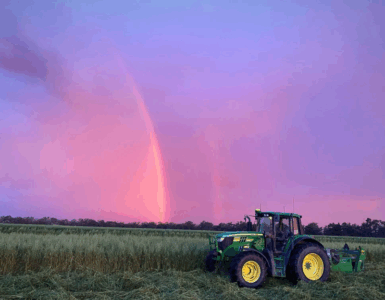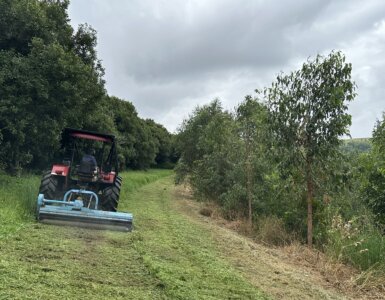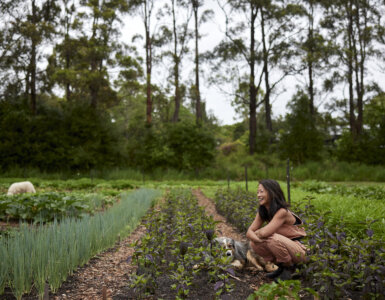Imagine going to work with hundreds of new strawberry prototypes awaiting taste testing. That’s all in a day’s work for Australia’s leading strawberry breeder.
Senior Scientist Dr Jodi Neal and her team have just perfected one that is pretty special. It’s a stunning white colour with bright red seeds and tastes a little like a pina colada! How did they do it? When can we buy it? So many questions. To learn more about this intriguing fruit, Queensland’s Department of Agriculture has kindly shared Dr Neal with us to offer a rare insight into the world of strawberries.

When we shop for apples for instance, we are spoilt for choice – Pink Lady, Gala, Fuji, Granny Smith. When it comes to strawberries however, it seems to most of us, a strawberry is a strawberry. Jodi explains the number one reason for developing new varieties is to give consumers more choice.
“They are all sold as the same thing, but some might taste different, others might have higher yields, some might have better shelf life. Consumers don’t currently get that information. What we wanted to do was, by having a strawberry that looks different and also tastes different, to be able to give consumers choice.”
Striking strawberries
Dr Neal and her team have been doing this for decades, so if you’ve bought strawberries in Australia at some point, chances are it was a variety they have developed. They’ve injected a lot of red strawberries into the market, but these are their first specialty variety. To produce the striking white strawberry, Jodi accessed some seeds from the US Department of Agriculture.
After multiple generations of crossing, we were able to get these white and also new pink varieties.
“They have a seed germ plasm bank where they collect seeds from all over the world. Through them, we were able to access some seed from a wild naturally white strawberry plant in Chile.
“We grew them up here in Queensland and used them as parents because those plants didn’t have all the characteristics that we need as a new variety. They were a bit small, a bit soft. So, we crossed them with our regular red ones. After multiple generations of crossing, we were able to get these white and also new pink varieties,” explains Jodi.

They’ve now succeeded in finding the right size, firmness and shelf life that our farmers need but they don’t just look good. The wild grandparent seeds have led to a unique flavour.
New look strawberry with a traditional taste
“There is a lovely aftertaste of pineapple which is different to regular strawberries but funnily enough is actually closer to the flavour that strawberries used to be many years ago,” she says. The scientific name for strawberries is Fragaria Ananassa. The latter actually means pineapple in some languages. So, we have a new look strawberry with a traditional taste.
There is a lovely aftertaste of pineapple which is different to regular strawberries but funnily enough is actually closer to the flavour that strawberries used to be many years ago.
The pale colour may confuse some shoppers into thinking the fruit isn’t ripe, but Jodi explains it’s easy to tell when these new strawberries are ready to eat.
“For our pink variety that we’ve released, it turns a peachy coloured blush on one cheek. It does that where the sun hits it. So, the side that’s open to the sun. When the peach colour has gone all the way to the top, where the stem is, that’s when you can tell it’s ripe.
“It can still be a creamy colour underneath and that’s fine. With the white one, the reddening of the seeds happens. So, similarly on the side where the sun hits, if you’ve got those red seeds, you know it’s ready.”
It sounds wonderful but it’s been a long road. There were some weird and wild strawberries that grew during the trial. Some of the white ones had embedded seeds deep in the fruit. Others have tasted like bubble gum and raspberries. This is why it took eight years to settle on the perfect variety!
It’s all done the old-fashioned way with flowers and pollen.
“The most common misconception about people in plant breeding is that we’re all doing genetically modified. In reality, what I do, people have been doing for over 10,000 years. It’s all done the old-fashioned way with flowers and pollen,” says Jodi.

Developing new fruit is about so much more than appearance and taste. Scientists need to look at growing conditions and disease resistance. It takes a long time to pick the best from each cross and start the process again.
“We look at bruise resistance, abrasion resistance, sugar levels, acidity levels, shelf life, bush size, plant architecture. A whole bunch of traits that we assess on all of our plants. That way, at each step, we are able to pick the best that we have available,” Jodi explains.
Strawberries for all Australia
Incredibly, even though Jodi is based at Nambour on Queensland’s Sunshine Coast, the team breeds for all of Australia’s strawberry farmers. There are many different environmental conditions to accommodate. Climate specificity and climate change are a big part of the program so farmers can eventually grow strawberries anywhere and at all times of the year.
“Being able to see the work that I do directly impacting people’s lives and income. That immediate feedback is quite astounding. There have been varieties that I’ve released where I’ve had growers say they would have gone broke if we hadn’t grown this particular variety of yours. That’s the biggest thing that resonates with me in my work,” Jodi shares.
If you’re intrigued by the new white strawberry, you’ll need to wait a little longer. They should be on shelves within one to two years. And keep an eye out for yet another variety, a dark shiraz coloured fruit coming to shops near you soon. Yum!
Hear more stories just like Jodi’s by subscribing to the Telling Our Story podcast on iTunes and follow podcast host Angie Asimus on Instagram for more updates.







































It is a great news.